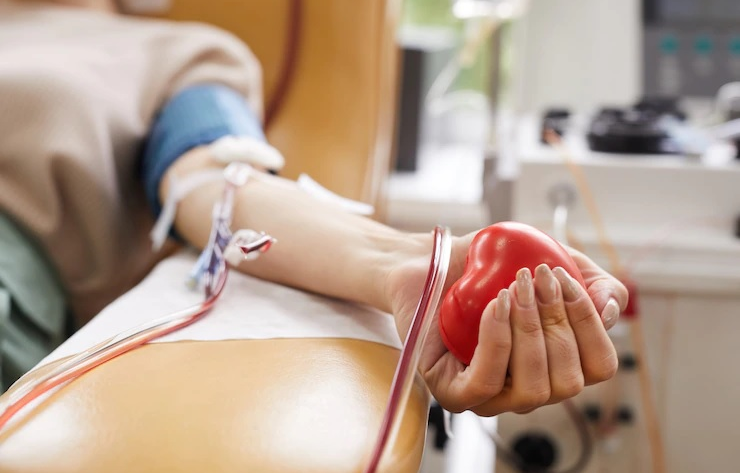Image : https://img.freepik.com/free-photo/close-up-patient-with-tubes-her-arm-squeezing-ball-her-hand-while-donating-blood_249974-4241.jpg
The patient needs to select the “right” kind of donation to put his/her life-saving donation to the best use possible. As donating blood saves lives, it may positively impact the world. And did you know that you may donate blood in various ways, each of which might benefit a different kind of patient?
Blood components other than plasma and platelets may be collected using specialized technologies in addition to the typical one pint of whole blood donation (a process called apheresis).
1. Whole Blood Donation
Instead of blood that has been broken down into its component components, the word referred to as “whole blood” denotes whole blood. It is the most common type of blood donation.
In many cases, the different components of donated whole blood may be isolated and utilized in transfusions after processing it. Platelets, red blood cells, and plasma are examples of these components. Transfusing a patient with their whole blood is only essential in a sudden and severe loss of blood.
2. Plasma Donation
By donating plasma, you may help treat patients in critical care by donating a component of your blood. Because AB plasma is compatible with all blood types, there is no limit on who may get it. Using an automated method, at first blood is collected and the plasma is separated from blood. As a next step, the plasma devoid blood is returned to your body safely and comfortably.
Donating plasma by automated aphereses, like donating whole blood, requires the exact prerequisites of donating blood. Donors must be at least 16 years old, weigh at least 110 pounds, and indicate that they are in a good mood on the day they intend to give blood and have a generally healthy physique. Anyone above sixteen must have a signed document from a parent or guardian authorizing them.
3. Power Red Donation
Patients who need blood transfusions as a part of their therapy will get a concentrated dose of red cells from your blood during a Power Red donation. Automated techniques are utilized to separate your red blood cells from the rest of your blood in this kind of donation.
Your plasma and platelets will be returned to you safely and pleasantly after this process. Vitalant power red donation often donates the red blood cells to trauma patients, newborns requiring emergency transfusions, sickle cell anemia sufferers, and anybody else who has lost blood.
4. Platelet Donation
With apheresis, a kind of automated platelet donation, a single donation may assist three different patients. When determining the maximum number of platelet doses collected, donor platelet count and time will play a factor. During a platelet donation, your platelets and some plasma will be removed using an apheresis machine.
However, your red blood cells and most of your plasma will be returned to you after the treatment. The manufacture of one transfusable platelet unit requires five contributions of whole blood, while one donation of platelets might produce several transfusable units.
Conclusion
Donating blood has a number of significant positive effects on one’s health, but obviously, the most crucial aspect of the practice is the fact that it may save lives. Your health will benefit by giving blood, but the lives of others who are in critical need of assistance will benefit much more.




